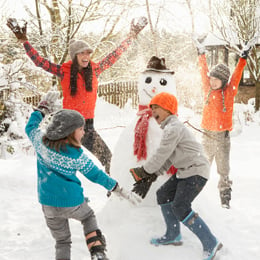
Winter in the Midwest and elsewhere can create significant challenges. While you may be getting a foot of snow, others may be getting freezing rain. The point is that winter can be unpredictable so it’s a good idea to be prepared for whatever Mother Nature throws your way.
Here are some safety tips to help keep you and your family safe and healthy this winter.
1. Do you know the difference between a storm watch and a warning? What about an advisory? Here are the definitions of potential storm activity from the National Weather Service:
a. Winter Weather Advisory
This means winter weather conditions are expected to cause significant inconveniences and may be hazardous. If you’re careful, these situations shouldn’t be life-threatening.
b. Winter Storm Watch
More severe than an advisory, a “watch” means winter storm conditions are possible within the next 36 to 48 hours. People in a watch area should review their winter storm plans and stay informed about weather conditions.
c. Winter Storm Warning
This is the most serious advisory. It means severe, life-threatening winter conditions have begun or will begin within 24 hours. People in a warning area should take precautions immediately.
2. Be aware of the actual temperature and wind chill. A sunny day with high winds may not be as warm as it first appears.
3. Set a time limit for your children to play outside. Have them come inside periodically; warming up can help prevent frostbite and hypothermia.
4. If you suspect you or your child has frostbite, submerge the affected areas in warm water. Never use hot water because it could damage the skin or surrounding tissue.
5. If you are outside on a sunny winter day, consider applying sunscreen to exposed skin. It may sound strange to use sunscreen in winter, but the sun’s rays can cause sunburn even when it’s cold outside.
6. If you’re snowmobiling or skiing on a sunny day, wear goggles or sunglasses with UV protection. Prolonged exposure to sunlight reflected from snow or ice can cause temporary blindness, also known as snow blindness.
7. When sledding, avoid roads and ensure plenty of room to stop safely. Also, when sledding, make sure your feet are first, or you’re sitting up. Never sled head first by lying on your stomach or back.
8. Wash your hands often. While cold temperatures don’t cause colds or the flu, these viruses are more common this time of year. Wash your hands OFTEN with soap and warm water to minimize your chance of catching a virus. Wash for at least 30 seconds, including the backs of your hands and between your fingers. Carry hand sanitizer with you and use it if soap and water aren’t handy. Lastly, try not to touch your eyes, nose, and mouth; this is a common way for germs to enter your body.
Do you have any suggestions or information you’d like to share? I’d love to hear from you. Please share them in the box below.





